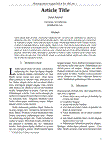| Sumario: | The typical approach to assessing the digestive capacity of marine fish larvae involves the histomorphological description and characterization of the digestive system and associated organs in relation to the developmental stage, as well as the quantification of digestive enzyme activities with biochemical and histochemical techniques. Although the biochemical quantification of digestive enzymes has been a very widespread and useful tool to assess the digestive capabilities of fish larvae, molecular tools have gained importance in the last decade to study the ontogeny of digestive enzymes gene expression, allowing the understanding of the mechanisms underlying the digestive physiology of young fish. The general patterns of the morphohistological development of the digestive tract and accessory glands might be also used as biomarkers of nutritional stress, since the digestive system is very sensitive to changes in diet quantity and quality. The literature indicates that there are certain tissular and cellular responses to food availability and quality, particularly in the digestive tissue, which is common to most teleost fish larvae. These responses, which are independent of water temperature, can be used for assessing fish larvae nutritional condition. In this regard, the microscopical organization of the liver hepatocytes, the intestinal mucosa and the exocrine pancreas, which are generally used as target tissues and organs to assess the nutritional condition of fish larvae, is deeply reviewed. The advantages and disadvantages of the use of different cellular biomarkers of effect are discussed considering different conditions
|
|---|
